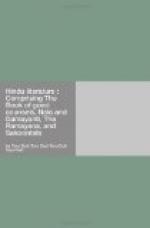The drama is undoubtedly the most intellectual, as it is the most artificial, form of poetry. The construction of the plot, and the arrangement of the action, give room for the most thoughtful and deliberate display of genius. In this respect the Greek drama stands forth as most philosophically perfect. The drama, moreover, has always been by far the most popular form of poetry; because it aids, as much as possible, the imagination of the auditor, and for distinctness and clearness of impression stands preeminent above both the epic narrative and the emotional description of the lyric.
The drama in India appears to have been a perfectly indigenous creation, although it was of very late development, and could not have appeared even so early as the Alexandrian pastorals which marked the last phase of Greek poetry. When it did appear, it never took the perfect form of the drama at Athens. It certainly borrowed as little from Greece as it did from China or Japan, and the Persians and Arabians do not appear to have produced any dramatic masterpieces. The greatest of dramatists in the Sanscrit language is undoubtedly Kalidasa, whose date is placed, by different scholars, anywhere from the first to the fifth century of our era. His masterpiece, and indeed the masterpiece of the Indian drama, is the “Sakoontala,” which has all the graces as well as most of the faults of Oriental poetry. There can be no doubt that to most Europeans the charm of it lies in the exquisite description of natural scenery and of that atmosphere of piety and religious calm—almost mediaeval in its austere beauty and serenity—which invests the hermit life of India. The abode of the ascetics is depicted with a pathetic grace that we only find paralleled in the “Admetus” of Euripides. But at the same time the construction of the drama is more like such a play as Milton’s “Comus,” than the closely-knit, symmetrical, and inevitable progress of such a work of consummate skill as the “King Oedipus” of Sophocles. Emotion, and generally the emotion of love, is the motive in the “Sakoontala” of Kalidasa, and different phases of feeling, rather than the struggles of energetic action, lead on to the denouement of the play. The introduction of supernatural agencies controlling the life of the personages, leaves very little room for the development and description of human character. As the fate of the hero is dependent altogether upon the caprice of superhuman powers, the moral elements of a drama are but faintly discernible. Thus the central action of Sakoontala hinges on the fact that the heroine, absorbed in thoughts of love, neglects to welcome with due respect the great saint Durvasas—certainly a trifling and venial fault—but he is represented as blighting her with a curse which results in all the unhappiness of the drama, and which is only ended at last by the intervention of a more powerful being. By this principle of construction the characters are




